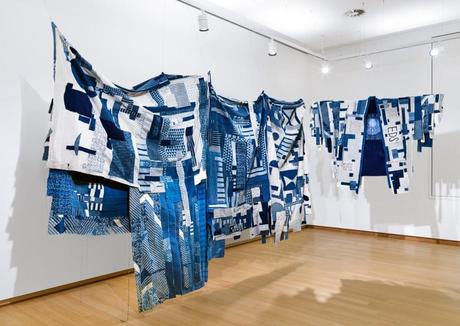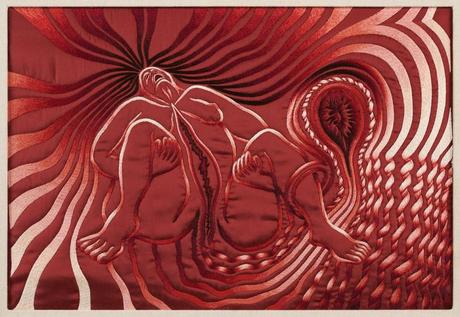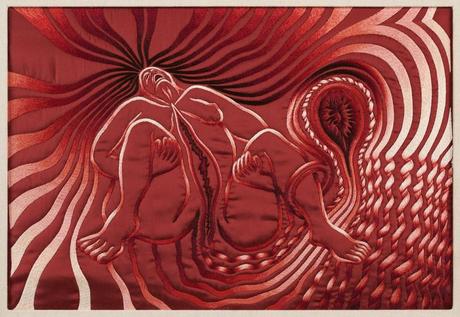
A baby blanket. A football shirt for children. A friend's shirt, a grandmother's dress. A shroud. There is something very evocative about fabric; we wear it, we use it to keep warm, to keep us safe; we give it a ritual meaning, we cherish it. Its intricate formation forms the basis of countless metaphors - we weave stories, tie ourselves in knots.
And yet textiles as an art form are consistently underestimated. It is often dismissed as 'craft' or 'women's work', where the association with the domestic transcends its versatility, resonance and complexity.
All this makes it perfect as a form of becoming political. That is the broad focus of this new exhibition at the Barbican, Unravel: The Power and Politics of Textiles in Art, with more than 100 works of art, from small embroideries to large installations, by 50 international artists, including Yinka Shonibare, Cecilia Vicuña, Magdalena Abakanowicz (recently the subject of a major solo exhibition at Tate Modern), Nicholas Hlobo and more. Many are likely new discoveries for visitors.
The show is organized thematically, although there is crossover. "Bearing Witness" leans hard into the political, with works like Mexican artist Teresa Margolles' community-made collages commemorating the police killings of black men and women, or the killing of 17-year-old Jadeth Rosano Lopez in Panama City , suffocated by his aunts.
A representation of made anonymously arpileras The felt and fabric depictions of gendered oppression or state-sponsored violence created under the Pinochet regime in Chile are deceptively simple but deeply powerful (usually their creation was initially dismissed as 'feminine, domestic and therefore apolitical activity'). at the end of his reign, Pinochet called them 'carpets of slander').
'Wound and Repair' is about physical and emotional recovery, with work by Louise Bourgeois (of course) and Dietrich Brackens, among others. The latter's tapestry, Fire Makes Some Dragons - in which a black figure engulfed in flames holds another out of the fire - explores the care and safety found in the community.
The story continues
It is inspired by a shocking 2016 statistic that suggested that, if current rates of diagnoses were to continue, approximately one in two black and one in four Latino men who sleep with men in the US would be diagnosed in their lifetime would get HIV. In contrast, Angela Su's delicate drawings, made entirely of stitched human hair, are extremely creepy and quite witty.
The idea of 'Borderlands' feels somewhat tenuous, although it is an opportunity to showcase the exuberant thread clouds of South African artist Igshaan Adams' installations, which explore hybrid identities and the idea of the 'desire path', something that takes on more weight in the strictly segregated world. context of apartheid. But "Subversive Stitch," a part of the show that focuses primarily on gender, is a rich addition, because for so long the medium of textiles has been considered the domain of women and valued accordingly.


Here, Judy Chicago addresses this directly with her Birth Project series, created in response to what the artist perceived as an "iconographic void" of birth imagery in Western art. True, you don't see it much, but here it is in all its glory in the quilted and embroidered panel Birth Tear/Tear, 1982, created from a Chicago design by the highly skilled volunteer Jane Gaddie Thompson and depicted in lush, psychedelic red side the pain of the vaginal tearing that often accompanies pushing out a baby.
Hanging nearby is Tracey Emin's No Chance (WHAT A YEAR), 1999, which recalls the year she was raped at age 13 in typically rough appliqué text, and several examples of LJ Robert's small, embroidered portraits of their LGBTQ+ friends, using an underappreciated medium to record the lives of the underrepresented.
This tribute to the everyday can be seen elsewhere under the theme 'Fabric of Everyday Life', in the work of artists such as Sheila Hicks, whose Family Treasures, 1993, consists of friends' beloved garments tied with colorful thread into small shiny bundles , piled high. like so many jewels, or the Filipino artist Pacita Abad, whose painted and intricately stitched hangings depict in vibrant colors the lives of migrants and refugees in the US, her adopted home.
'Ancestral Threads', which occupies most of the ground floor of the gallery and houses some of the most monumental works, features artists looking back on textile history. Some shed light on the consequences of globalism and trade. Antonio Jose Guzman and Iva Jankovic's patchwork quilt, dyed with precious indigo, recalls the exploitation of enslaved African people who brought with them expertise in its cultivation; at one point a piece of indigo cloth was equated in monetary value to one enslaved human being.
Others revive stories or techniques from the past, such as Mercedes Azpilicueta's monumental tapestry panel that riffs in a wonderfully surreal way on the popular Argentine legend of Lucia Miranda, the first cautiva - a white woman captured by the indigenous population, or Myrlande Constant, whose stunning, heavy beadwork is inspired by the Haitian Vodou religion. The drapo Vodou (a flag depicting the ghosts) shown here is a breathtaking, shimmering riot of figures that rewards long viewing.
As with most Barbican exhibitions, limited in some ways by the sheer size of the space, there may be a little too much to see. At first you certainly feel like there's far too much text - but actually, apart from a few irritating errors in silly art talk, the explanations on the walls, for almost all the pieces, are both informative and genuinely interesting. Not every work will resonate, but it is never less than fascinating. Give yourself time for this show to explode.
Barbican Art Gallery, February 13 to May 26; barbican.org.uk